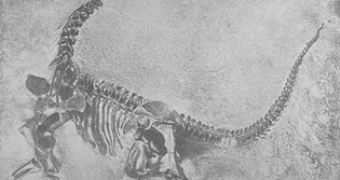Scientists have been trying for years now to understand how from an egg just a few times bigger than an ostrich the biggest beasts that ever roamed the Earth could grow. The fossil of a baby dinosaur that lived 140 million years ago could explain how the ancient beasts could have developed from youngsters to enormous adults, over 20 m (60 ft) long. This dinosaur was found in 1999 from diggings in the Lower Morrison Formation of the Howe Ranch in Bighorn County, Wyoming. It is estimated to have been about 1 year old when it perished, towards the end of the Jurassic Period (206 million to 144 million years ago). "It's the only complete skeleton of a juvenile sauropod we know of," said lead researcher Daniela Schwarz of the Natural History Museum in Basel, Switzerland.
The 2 m (6 ft) long baby dinosaur is a sauropod from the family Diplodocidae, which compassed the well-known four-legged plant-eaters equipped with long, slender Tails and necks. Previous studies have suggested that the diplodocids used their tails as whipping weapons. Apatosaurus louisae was found to crack its tail at supersonic speeds to generate a ground-shaking boom. "We do not know very much about sauropods of this age. So it's not clear how much they change when they grow, and that makes comparisons [with adults] very difficult." said Schwarz.
Unfortunately, the skeleton lacks exactly a tiny portion at the end of the tail so that the researchers can't clearly tell if the juvenile also had the whiplash tail. A mature Apatosaurus louisae reached a shoulder height of about 10 feet (3.3 ft), with a nose-to-tail length of 60 feet (20 m), whereas the offspring was just about 2 ft (0.66 m) tall at the shoulder. Still, Apatosaurus was average sized amongst diplodocids; Supersaurus - the largest terrestrial animal ever - could reach 40 m (133 ft) in length, more than a blue whale (but it was lighter).
The baby's limb bones display similar proportions to those of adult diplodocids, but its relatively short neck and lengthy mid-section don't fit the proportions of the full-grown relatives. "The vertebrae column gets shorter during growth, so the adult specimens have shorter trunks, for example, than the juveniles, at least in this species," Schwarz told LiveScience.
Plant fossils discovered at the site point to the fact that the dinosaur died in a watering hole "deathtrap" in a Jurassic swampland. "The locality represents sort of a swampy environment where dinosaurs came and drank. One possibility is that while drinking, they were caught in the swamp sediments and they died.", said Schwarz.

 14 DAY TRIAL //
14 DAY TRIAL //